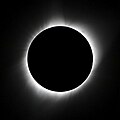| Partial eclipse | |
| Gamma | 1.0861 |
|---|---|
| Magnitude | 0.8078 |
| Maximum eclipse | |
| Coordinates | 62°36′N81°06′E / 62.6°N 81.1°E |
| Times (UTC) | |
| Greatest eclipse | 9:48:24 |
| References | |
| Saros | 122 (53 of 70) |
| Catalog # (SE5000) | 9348 |
A partial solar eclipse occurred at the Moon's descending node of orbit on Monday, November 12, 1928, [1] with a magnitude of 0.8078. A solar eclipse occurs when the Moon passes between Earth and the Sun, thereby totally or partly obscuring the image of the Sun for a viewer on Earth. A partial solar eclipse occurs in the polar regions of the Earth when the center of the Moon's shadow misses the Earth.
Contents
- Eclipse details
- Eclipse season
- Related eclipses
- Eclipses in 1928
- Metonic
- Tzolkinex
- Half-Saros
- Tritos
- Solar Saros 122
- Inex
- Triad
- Solar eclipses of 1928–1931
- Saros 122
- Metonic series
- Tritos series
- Inex series
- References
- External links
A partial eclipse was visible for parts of Northeast Africa, Europe, West Asia, Central Asia, and South Asia.







































































































